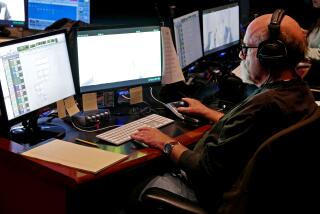The Sounds of Silence
- Share via
In the middle of nowhere in Switzerland, the “silence syndrome” sucker-punched a New York composer named Raphael Mostel.
Miles from the nearest shrieking car alarm or caboose-sized boombox, he found himself unable--for several days--to hear certain birds because “my ears were closed down from the bombardment of noise [at home].”
“I was with a Swiss friend who kept saying, ‘Listen to that, listen to that,’ but I didn’t hear anything,” Mostel recalls. “It took a couple of days before I [could tune in].”
Such reactions aren’t unusual.
Under the reign of leaf blowers, stereo-blasting restaurants and TV-sprinkled lounges, silence has become so rare that the human ear--and mind--often can’t deal with it.
Although many people say they yearn for peace and quiet, in practice they seem to dread it. They flip on the television for background noise, drive to work with the car radio blaring and exercise to the strains of stereo-headphone concertos.
People who think about these things cite a number of possible causes for such behavior, from spiritual emptiness to a theory that people are using sound to mark territory. Psychologists say the brain craves audio stimulation so much that it might be addicted to noise.
How addicted?
Well, let’s put it this way: In Orange County, even cemeteries are starting to pipe in songs.
Silence hasn’t always been so disquieting.
Monks once flocked to deserts searching for it. Musicians wrote pieces immersed in it (Beethoven inserted 40 crucial pauses in the opening minutes of his Fifth Symphony). And scientists and philosophers analyzed it.
Now, it’s practically unheard of.
That’s partly a function of physics: Even inside an anechoic chamber--a room that absorbs all sound--the ear still detects noise.
“I heard two sounds, one high and one low,” wrote the late composer John Cage after visiting Harvard’s “sound-free” cubicle. The low noise was his blood circulating; the high was his nervous system.
Others are able to hear the joints of their fingers rubbing against each other, says Kenneth Feith, a senior scientist and noise specialist at the Environmental Protection Agency.
The conclusion: Absolute quiet doesn’t exist.
In 1952, Cage tried to dramatize the effect with a composition titled “4’33”,” in which a pianist strode onstage and sat motionless at the keyboard for 4 minutes and 33 seconds.
Talk about awkward silences. “I wanted audiences to listen to everything else they might hear, the natural state of the universe,” he said later.
Instead, the performance evoked uneasiness and agitation.
Small wonder. As Feith discovered while conducting anechoic chamber experiments in college, “most people couldn’t stay in there more than a few minutes.”
*
Silence forces humans to be with themselves--free from distraction--and it’s typically an unfamiliar, unwelcome experience. “During World War II and in Vietnam and Korea, absolute silence was used as a torture mechanism,” Feith notes.
Silence has other drawbacks, as well (for example: mimes). But experts say it also holds a key to mental and spiritual well-being.
However, those benefits are increasingly hard to come by now that all of life seems to have its own soundtrack. From elevators to restrooms to waiting on hold on the telephone, the musical assault has become almost impossible to escape.
In New York, the audio onslaught is so pervasive that one newspaper reader was “regaled with light hillbilly music while strapped into an MRI machine at NYU Medical Center.”
Columnist Russell Baker blames the silence shortage on “society’s determination to entertain you whether you like it or not.”
Or whether you’re dead or alive. In Garden Grove, canned choir and organ music tinkles through the light fixtures at the Crystal Cathedral’s cemetery.
*
Composer Mostel suspects something primeval in all the racket: that people are using sound to establish territory. For example, humans who crank up car stereos to decibel-defying levels “need to be enveloped with sound as a physical space or environment. It’s their territory.” It’s the same as birds and animals marking turf or seeking attention with noise, he says.
Compounding the warped perception of sound and silence, Mostel says, is the media’s use of noise.
Sometime around the 1960s, for example, radio stations began employing a device that automatically slices out dead air time from prerecorded music and conversation, he says: “It makes things faster.”
And in movies, he adds, “Everything’s being cranked up because there’s this fear of allowing a silence.” Consider the sound of a cinema doorknob opening: “No real doorknob makes that kind of noise,” he says. “No shoe makes that much sound on a sidewalk.”
A study done after microphones were added to Broadway plays found that ticket sales dropped when the volume was turned down, Mostel says. The reason: People got so used to hearing amplified sound that they could no longer pick up everything without it.
For that reason, when Mostel performs his avant-garde music, he has “avoided using power of any sort in order to have the audience hear sound in its pristine form and to make them work and listen a little bit.”
*
Across the country, at the tranquil grounds of Mission San Luis Rey, near Oceanside, Father Rusty Shaughnessy, a Franciscan friar, suggests that the noise epidemic is a spiritual problem.
“There’s a real emptiness in people’s lives,” he says. “Not of stuff, because we have plenty of stuff in this country, but of intimacy and connectedness. So we try to fill that emptiness with food, videos, sound.”
Quoting ancient monks and philosophers, Shaughnessy argues that the human spirit requires silence “just as much as the body needs oxygen.”
Of course, the religious dimension to silence is long-standing. “Be still and know that I am God,” the Bible says.
Matthew Kelly, a Catholic mystic from Australia, agrees. In his new book “A Call to Joy” (Harper Collins), he writes: “Noise is the mouthpiece of the material world. Silence is the mouthpiece of the supernatural realm. . . . If we cannot hear the voice of God in our lives, it is not because He is not speaking; it is because we are drowning [Him] out with so much other useless noise.”
*
Then again, humans might simply be slaves to noise.
According to Century City psychologist and attorney Rex Julian Beaber, the brain is a junkie for sensory stimulation.
“Consciousness abhors a vacuum,” he says, explaining that the mind’s hunger for information is like the body’s drive for food--and that both have become twisted by technology.
“We were given a gene that drives us to seek out and consume fat and sugar because they’re crucial for survival,” Beaber says. “Then, along came modern technology and food became plentiful. Now, instead of burning 4,000 calories a day chasing 4,000 calories to eat, we spend just 200 calories a day chasing that 4,000. The drive that once helped us survive is enslaving us because we can’t turn it off.”
Ditto for the brain’s built-in desire for aural, visual and other sensory input: “We can’t stop ourselves from consuming useless stimulation.”
That’s why TV is so popular, he says: “It’s like a Big Mac for the brain.”
This might also explain Hollywood’s obsession with ever-increasing special effects, explosions and volume in movies.
“At some point, we always become satiated on whatever is the current mode of stimulation,” Beaber says. “So someday, TV won’t be sufficient and we’ll have reached our capacity to imbibe special effects. I suspect that the next great leap forward--or backward--is that somebody will find a replacement to the passive-receptive mode of stimulation. It will be a momentous historical event.”
One possibility: Virtual-reality experiences through direct stimulation of the brain. “I’ve seen patents for such things,” Beaber says.
*
But all the sensory overload does have consequences.
“If you’re filling your mind with anything directed and produced by another, you can’t be creative or contemplative,” Beaber warns. “You’re living in the ‘here-and-now’ instead of in the ‘when-and-if.’ Anyone who lives only in the present guarantees a pleasant few seconds and a very painful future. . . .
“Human consciousness is at its most divine point not in the here-and-now, but in the when-and-if. That’s when we’re better than an ape.”
Albert Mehrabian, professor emeritus of psychology at UCLA, agrees: “Being quiet forces you to think, to examine yourself, to look at where you’ve been and where you’re going.”
Unfortunately, he adds, TV has “trained people to be passive recipients of information . . . [so] even when they do get into their thoughts, hopes and fears, they want somebody else to be present--like a therapist--to tell them what to think. . . . We’ve raised generations of automatons.”
Is there a better way?
Maybe, says Beaber, but it won’t be easy. “We can’t extinguish the instinct [for clatter]. All we can do is kinda struggle against it. Some do that by joining religious cults or monasteries that cut them off from civilization and the media.
“My own view is that Aristotle was right: Wisdom is in the wise balance, not in the extremes. We’d be happier not if we don’t watch TV anymore or have a Walkman anymore, but if we have a more varied relationship with the world, which would include periods of silence, such as days without newspapers or TV.”
To put it in spiritual or musical terms, life is intended to be a symmetry of silence and sound.
“There is a time for everything,” says the book of Ecclesiastes, “a time to speak and a time to be silent.”
Or, as a London newspaper recently explained: For Beethoven and Stravinsky, “an exactly measured silence was equivalent to an exactly measured sound and the interaction of the two was what constituted rhythm.”
A rhythm of life, perhaps?
Yes, says composer Mostel: “Silence is never empty.”
More to Read
The biggest entertainment stories
Get our big stories about Hollywood, film, television, music, arts, culture and more right in your inbox as soon as they publish.
You may occasionally receive promotional content from the Los Angeles Times.










